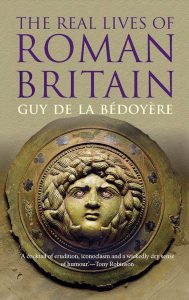From the Archives: Reading My Way Through Roman Britain, Pt. 2
The places I hang out on line are having a lot of fun theses days with the question of how often men think about the Roman Empire. The answer apparently being, a lot. (Really?) I have no idea who started it, or why. But it’s a natural for history nerds being nerdy. It has spawned fun memes, and lots of playful silliness at a time when some of us need that.
I don’t have an answer. (And I haven’t asked My Own True Love the question.) But for those of you who are interested in thinking about the Roman Empire for at least a short while, I’m re-running this series that I orginally posted in 2015. With any luck, by the time the series has run its course I will have finished these endless revisions and we can go back to thinking about women journalists, Nazi Germany, fascism in general, and whatever else grabs my history nerd attention.
Guy de la Bédoyère’s The Real Lives Of Roman Britain: A History of Roman Britain Through The Lives of Those Who Were There is not a narrative history of Roman Britain. (De la Bédoyère has already written several versions of that narrative.) It is instead an attempt to look at the 360 years of Roman occupation in terms of human experience rather than “the generalities of military campaigns, the antics of emperors, the arid plains of statistical models and typologies of pottery, the skeletal remains of buildings, and theoretical archaeological agendas.” [p.xi]
The attempt is not entirely successful due to a problem that de la Bédoyère identifies early in the book as “visibility”. There is surprisingly little evidence, physical or textual, about the Roman experience in Britain and even less about individuals–often no more than a name and a hint. (Sometimes not even a name. One individual, known as the “Aldgate-Pulborough potter”, is recognizable only by the distinctive incompetence of his work.) Consequently, much of the book is devoted less to the lives of Roman Britain and more to an evaluation of the available evidence.
In lesser hands, this close analysis of inscriptions, clay tablets, pottery shards, and, yes, the skeletal remains of buildings could be as dry as the dust from which they are taken. De la Bédoyère considers each bit of evidence with wit and imagination, leading the reader with him on the path of discovery rather than simply providing her with his conclusions.





